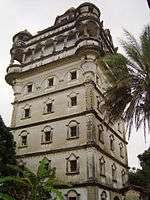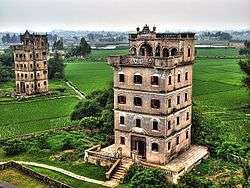Kaiping
| Kaiping 开平市 | |
|---|---|
| County-level city | |
|
Dixi Road in Chikan, Kaiping | |
.png) Location of Kaiping City (pink) in Jiangmen City (yellow), Guangdong province, and the PRC | |
 Kaiping Location of the city centre in Guangdong | |
| Coordinates: 22°22′N 112°41′E / 22.367°N 112.683°ECoordinates: 22°22′N 112°41′E / 22.367°N 112.683°E | |
| Country | People's Republic of China |
| Province | Guangdong |
| Prefecture-level city | Jiangmen |
| County seat | Changsha Subdistrict (长沙街道) |
| Area | |
| • Total | 1,659 km2 (641 sq mi) |
| Population (2010 census) | |
| • Total | 699,242 |
| • Density | 420/km2 (1,100/sq mi) |
| Time zone | China Standard (UTC+8) |
| Postal code | 529300 |
| Area code(s) | 0750 |
| Website | www.kaiping.gov.cn |
| Kaiping | |||||||||||||||||
| Simplified Chinese | 开平 | ||||||||||||||||
|---|---|---|---|---|---|---|---|---|---|---|---|---|---|---|---|---|---|
| Traditional Chinese | 開平 | ||||||||||||||||
| Taishanese Jyutping | Hoi3-pen6 (local) | ||||||||||||||||
| Hanyu Pinyin | Kāipíng | ||||||||||||||||
| Postal | Hoiping | ||||||||||||||||
| |||||||||||||||||
Kaiping, formerly romanized as Hoiping,[lower-alpha 1] is a county-level city in Guangdong Province, China. It is located in the Pearl River Delta and administered as part of the prefecture-level city of Jiangmen. The area is the ancestral homeland of many overseas Chinese, particularly in the United States. It has a population of 680,000 as of 2003 and an area of 1,659 square kilometres (641 sq mi).[2] The locals speak a variant of the Taishan dialect.
History
Under the Qing, Kaiping County made up part of the commandery of Zhaoqing.[1] It was promoted to county-level city status in 1993.
Administration
Administratively, Kaiping is administered as part of the prefecture-level city of Jiangmen.
| Name | Chinese (S) | Hanyu Pinyin | Population (2010)[3] |
|---|---|---|---|
| Sanbu Subdistrict | 三埠街道 | Sānbù Jiēdào | 173,100 |
| Changsha Subdistrict | 长沙街道 | Chángshā Jiēdào | 124,829 |
| Shatang Town | 沙塘镇 | Shātáng Zhèn | 24,667 |
| Chacheng Town | 苍城镇 | Cāngchéng Zhèn | 26,750 |
| Longsheng Town | 龙胜镇 | Lóngshèng Zhèn | 26,161 |
| Dasha Town | 大沙镇 | Dàshā Zhèn | 22,298 |
| Magang Town | 马冈镇 | Mǎgāng Zhèn | 30,728 |
| Tangkou Town | 塘口镇 | Tángkǒu Zhèn | 22,626 |
| Chikan Town | 赤坎镇 | Chìkǎn Zhèn | 37,260 |
| Baihe Town | 百合镇 | Bǎihé Zhèn | 17,621 |
| Xiangang Town | 蚬冈镇 | Xiǎngāng Zhèn | 13,280 |
| Jinji Town | 金鸡镇 | Jīnjī Zhèn | 16,493 |
| Yueshan Town | 月山镇 | Yuèshān Zhèn | 46,700 |
| Chishui Town | 赤水镇 | Chìshuǐ Zhèn | 25,894 |
| Shuikou Town | 水口镇 | Shuǐkǒu Zhèn | 90,835 |
Geography
Kaiping City is located 140 kilometres (87 mi) away from Guangzhou, in the southwestern part of the Pearl River Delta. Kaiping consists of three port cities: Changsha, Xinchang, and Dihai.
Sights
Kaiping Diaolous (碉楼) are fortified multi-storey towers which were constructed in the Kaiping area from the early Qing Dynasty, reaching a peak in the 1920s and 1930s, when there were more than three thousand of these structures. Today, approximately 1,800 diaolou are still standing. The diaolou served two purposes: housing and protecting against forays by bandits. The Kaiping diaolou and villages were added to the list of UNESCO World Heritage Sites in 2007.
 Rui Shi Diaolou
Rui Shi Diaolou- South Building
 Diaolou
Diaolou
Kaiping has traditionally been a region of major emigration abroad, and a melting pot of ideas and trends brought back by overseas Chinese made good. As a consequence, several watchtowers incorporate architectural features from China and the West.
Examples include:
- Ruishi Diaolou, located behind Jinjiangli Village, Lianggang Township. Constructed in 1921, it has nine floors and is the highest diaolou at Kaiping. It features a Byzantine style roof and a Roman dome.
- The diaolou cluster spread across the three villages of Anhe li, He'an li and Yong'an li has 15 diaolou and houses
- Li Garden, in Beiyi Xiang, was constructed in 1936 by Mr. Xie Weili, a Chinese emigrant to the United States.
- Fangshi Denglou - Built in 1920 after contributions from villagers, this denglou is five storeys high. It is referred to as the "Light Tower" because it had an enormous searchlight as bright as the beam of a lighthouse.
- Bianchouzhu Lou (The Leaning Tower), located in Nanxing Village was constructed in 1903. It has seven floors.
- The "Southern Diaolou" located on the riverbank, which was known for seven local soldiers by the surname 司徒 who defended it from the Japanese.
Miscellaneous
Kaiping has been twinned with Mesa, Arizona, United States, since October 18, 1993.
Kaiping was a major source of emigrants at the turn of the 20th century. As a result, a large number of early Chinese Canadian and Chinese American communities had people who originated from Kaiping and its neighboring counties of Taishan, Enping and Xinhui. It is said that there are more Kaipingnese people living abroad today than there are Kaipingnese in Kaiping.
In 1973, various people originated from Kaiping started the Hoi Ping Chamber of Commerce Secondary School in Hong Kong.
Notes
- ↑ The Postal Map romanization is based on the local Cantonese pronunciation. Other romanizations include Kae Ping.[1]
References
Citations
- 1 2 Bolton & al. (1941), p. 262.
- ↑ "Profile of Kaiping" (in Chinese). Archived from the original on January 18, 2010. Retrieved 2008-07-12.
- ↑ shi, Guo wu yuan ren kou pu cha ban gong; council, Guo jia tong ji ju ren kou he jiu ye tong ji si bian = Tabulation on the 2010 population census of the people's republic of China by township / compiled by Population census office under the state; population, Department of; statistics, employment statistics national bureau of (2012). Zhongguo 2010 nian ren kou pu cha fen xiang, zhen, jie dao zi liao (Di 1 ban. ed.). Beijing Shi: Zhongguo tong ji chu ban she. ISBN 978-7-5037-6660-2.
Bibliography
- Bolton, Kingsley; et al. (1941), Triad Societies, Vol. 5, Abingdon: Routledge, reprinted 2000.
External links
| Wikimedia Commons has media related to Kaiping. |
- http://english.kaiping.gov.cn/gover_affair.asp?InfoId=1205&ClassId=72 (Kaiping Press Release for future high speed rail station)
-
 Kaiping travel guide from Wikivoyage
Kaiping travel guide from Wikivoyage - Kaiping government website
- Information about the diaolou

